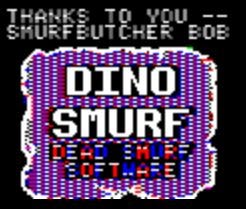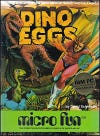
Featured Blog | This community-written post highlights the best of what the game industry has to offer. Read more like it on the Game Developer Blogs or learn how to Submit Your Own Blog Post
Labor of Love
Part Six. These are my memories of writing some of the earliest 8-bit games (CRISIS MOUNTAIN, DINO EGGS, SHORT CIRCUIT)... and now reviving my best-selling game as DINO EGGS: REBIRTH -- which debuts on Steam this Thursday June 9, 2016

Previous Post: How Much is 48K?
1983. I had spent a year writing Dino Eggs, as I describe in my previous posts. Even before that game was published, I had begun work on my third game, tentatively called BombBoozle, eventually published in 1984 as Short Circuit.
But the golden era of do-it-yourself 8-bit game authorship was waning. The era of specialization – of design by committee, and licensing by corporation – was fast approaching.
 The publisher of Dino Eggs filed for bankruptcy in 1985. They had placed too big a bet on ColecoVision, a console that blazed across the sky and flamed out just as quickly.
The publisher of Dino Eggs filed for bankruptcy in 1985. They had placed too big a bet on ColecoVision, a console that blazed across the sky and flamed out just as quickly.
Fortunately, I have always retained the underlying rights to my games, and both Crisis Mountain and Dino Eggs were soon re-published in various formats, including SoftDisk magazine, thanks to John Romero (of Doom and Wolfenstein 3D fame).
Within a few years, I was working on very early online games for Broderbund Software and Quantum Computer Services (later to become America Online). I was helping to nurture the infant internet – the medium that would, in time, make clear to me how special Dino Eggs was to so many people.
Because before the internet – How could I know that?
Dino Eggs appeared on some industry magazine best-seller lists in the months after its release. My royalty statements were encouraging, if not overwhelming.
I would later learn that my publisher had neglected to inform me of all of the countries in which they had sub-licensed the game -- thus systematically under-reporting its sales. So, even today, I can only guess how well Dino Eggs sold around the world.
 Sometime in the late 80’s, I heard someone talking about a game called Dino Smurf. Huh? The way people talked about it, it sounded very similar to my game, but it somehow involved dead Smurfs...?
Sometime in the late 80’s, I heard someone talking about a game called Dino Smurf. Huh? The way people talked about it, it sounded very similar to my game, but it somehow involved dead Smurfs...?
What...?!
It took quite a while for me to put the pieces together. I believe John Romero may have explained it all to me when he was organizing his first Apple II reunion.
Two particularly ambitious hackers – Andrew Johnson and Preston Nevins – had not only modified Dino Eggs into the first of an intended trilogy of Smurf-smashing parodies, they got their floppy disks to “go viral” long before that phrase had currency. I’ve since heard from many gamers who loved Dino Smurf, and never knew that there was an underlying game in there called Dino Eggs.
Thus, to my knowledge, Dino Eggs was the world’s first home computer game to be modded (and distributed beyond the hacker’s garage or attic). Let me know if I am wrong.

1983 – 2013. Gradually, the internet took hold. Gradually, search engines could help game fans find game authors. Gradually, I began to get a lovely stream of emails...
"Your games rocked! They had this polish to them that very few others had."
"My entire family was addicted to DINO EGGS. We would stay up until 2 a.m. playing and fighting over whose turn it was... This game actually cemented us together as a family.”

"Your games became my favorite. I love your games because they’re everlasting."
And – most rewarding of all – emails in which a fan tells me that my games inspired his entry into the computer game industry:
"DINO EGGS impressed me the way the 3-D perspective did in HADRON. As a game-maker I've tried to emulate that drive you demonstrated in my own art. DINO EGGS continues to influence the way I create to this day."
When a game or story works, it feels so right that it also feels natural and inevitable. We take for granted the delicacy of its fabric, let alone the time and effort it probably took to weave.
 It took baseball decades of adjustments in the 19th century to figure out what “balls” and “strikes” were – and how many of each it should take to send the batter either to first base, or back to the dugout. The limit for both balls and strikes started near ten, and only gradually got whittled down to four balls and three strikes.
It took baseball decades of adjustments in the 19th century to figure out what “balls” and “strikes” were – and how many of each it should take to send the batter either to first base, or back to the dugout. The limit for both balls and strikes started near ten, and only gradually got whittled down to four balls and three strikes.
Changing one rule can change everything. Consider football, basketball, baseball, and soccer. Within each of these sports -- Is a player allowed to be taken out of a game, and then returned to play?
For football and basketball, the answer is Yes of course! It’s difficult to imagine those sports being played otherwise. By denying players free substitution, football and basketball would become bizarre, almost sadistic spectacles of endurance.
For baseball and soccer, the answer is No of course not! It’s difficult to imagine those sports being played otherwise. By allowing players free substitution, baseball and soccer would become carnivals of highly specialized athletes, deflating many core strategies of the game, not to mention slowing them down.
Such a simple concept – player substitution – seemingly not central to these sports at all. And yet if you yank out that thread, the fabric of the game begins to fall apart.
If I ever had a chance to revisit Dino Eggs, what threads of the game would I dare to pull?
Over the years, I have had probably six or eight people ask me for permission to write a version of Dino Eggs. Most have done so for their own private edification. Some had hoped to market the new game, but did not complete the work.
Eric Ferrot – ten years old when the original game came out – was different. Having gained my permission, he crafted a lovingly-accurate and intriguingly-expansive version he called “Dino Legs.” I was charmed and inspired. Creating a partnership between Washington State (me) and Luxembourg (him), Eric and I joined forces to revive Dino Eggs as a commercial product.
Thus, our labor of love – Dino Eggs: Rebirth.


Dino Eggs – like anything else held in fond memory – has become so many different things to so many different people.
Having seen early graphics for Dino Eggs: Rebirth, one blogger reminisces about the “inspiring” blank black background of the original game and asked, “How could you turn something so atmospheric and beautiful into something so ugly and generic?”
Folks who love both Dino Eggs and Crisis Mountain send me fan art mixing characters and creatures between the two games. To these few, having Betrum the Bat (from Crisis Mountain) show up in Dino Eggs: Rebirth would have the impact of Mister Spock appearing in a Star Wars movie.
One reviewer of the original game on YouTube speculates on the sexual relationships between Time Master Tim and the prehistoric creatures around him. (It’s actually great fun!)
And yet, there are also common themes in my Dino Eggs emails.
Many families, young and old, continue to play Dino Eggs together.
Dino Mom still gives everyone a kick.
It is a rich and deep game like baseball. Slow at first glance, it rewards return and contemplation.
These were the qualities that Eric and I wanted to build on.
When sitting down to write the original Dino Eggs in 1982, I faced the question What Did 'Better' Mean?
That same question now loomed for Dino Eggs: Rebirth...
What does a 'better' Dino Eggs mean now...?
To Be Continued...
In the meantime, I invite you to check out our Dino Eggs: Rebirth videos and blogs, and – if you are so inspired – vote for the game on Steam Greenlight.
(Update: The new game Dino Eggs: Rebirth debuts on Steam this Thursday June 9, 2016.)
Next post: Everything Old is New Again
Read more about:
Featured BlogsAbout the Author(s)
You May Also Like







.jpeg?width=700&auto=webp&quality=80&disable=upscale)








